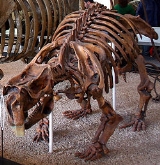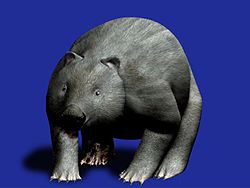
Phascolonus
Encyclopedia
Phascolonus was a genus of prehistoric Australian marsupial
in the wombat
family. The largest species, Phascolonus gigas weighed as much as 200 kg. Phascolonus existed alongside with an even larger marsupial, Diprotodon
, which weighed as much as two tons and was distantly related to wombats. Both disappeared at the end of the Late Pleistocene
in a Quaternary extinction event
together with many other large Australian animals.
 At Tea Tree Cave a two million year old Phascolonus fossil was found alongside that of the crocodilian Quinkana
At Tea Tree Cave a two million year old Phascolonus fossil was found alongside that of the crocodilian Quinkana
.
Marsupial
Marsupials are an infraclass of mammals, characterized by giving birth to relatively undeveloped young. Close to 70% of the 334 extant species occur in Australia, New Guinea, and nearby islands, with the remaining 100 found in the Americas, primarily in South America, but with thirteen in Central...
in the wombat
Wombat
Wombats are Australian marsupials; they are short-legged, muscular quadrupeds, approximately in length with a short, stubby tail. They are adaptable in their habitat tolerances, and are found in forested, mountainous, and heathland areas of south-eastern Australia, including Tasmania, as well as...
family. The largest species, Phascolonus gigas weighed as much as 200 kg. Phascolonus existed alongside with an even larger marsupial, Diprotodon
Diprotodon
Diprotodon, meaning "two forward teeth", sometimes known as the Giant Wombat or the Rhinoceros Wombat, was the largest known marsupial that ever lived...
, which weighed as much as two tons and was distantly related to wombats. Both disappeared at the end of the Late Pleistocene
Late Pleistocene
The Late Pleistocene is a stage of the Pleistocene Epoch. The beginning of the stage is defined by the base of the Eemian interglacial phase before the final glacial episode of the Pleistocene 126,000 ± 5,000 years ago. The end of the stage is defined exactly at 10,000 Carbon-14 years BP...
in a Quaternary extinction event
Quaternary extinction event
The Quaternary period saw the extinctions of numerous predominantly larger, especially megafaunal, species, many of which occurred during the transition from the Pleistocene to the Holocene epoch. However, the extinction wave did not stop at the end of the Pleistocene, but continued especially on...
together with many other large Australian animals.

Quinkana
Quinkana is an extinct genus of mekosuchine crocodile that lived in Australia from ~24 million years ago to ~40,000 years ago. By the Pleistocene Quinkana had become one of the top terrestrial predators of Australia, possessing long legs and ziphodont teeth .Ziphodont teeth tend to arise in...
.

